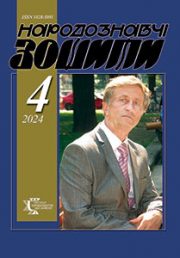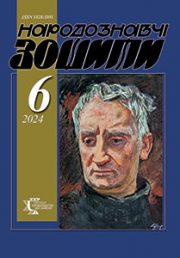The Ethnology Notebooks. 2024. № 1 (175), 96—108
UDK 94(430.129=161.2)”1991/2015″:314.151
DOI https://doi.org/10.15407/nz2024.01.096
UKRAINIANS IN BAVARIA: MIGRATION AND INTEGRATION ASPECTS (1991— 2015)
MARKHVINSKYI Ivan
- ORCID ID: https://orcid.org/0009-0002-5178-3511
- Graduate Student,
- Ivan Franko National University of Lviv,
- Department of Modern World History,
- 1, Universytetska str., 79000, Lviv, Ukraine,
- Contacts: e-mail: Iwan17@ukr.net
Abstract. Introduction. Migration processes from Ukraine to Germany accelerated markedly in the early 1990s. This led to the formation of a powerful Ukrainian community, and Bavaria became one of its most important centers, along with Berlin.
Problem Statement. The study of Ukrainian migration to Germany after Ukraine gained independence is rather sporadic and focuses mainly on cultural issues. At the same time, even less attention has been paid to the complex issues of the situation of Ukrainians in individual German federal states. Thus, the Ukrainian community in Bavaria requires a more detailed and comprehensive study, especially when it comes to the coverage of migration processes in the period from 1991 to 2015.
Purpose. Our article aims to analyze the main features of the Ukrainian migration movement to Bavaria from 1991 to 2015, to characterize the integration of Ukrainians into German society, and to highlight the activities of the main Ukrainian national, cultural, and educational organizations.
Methods. In preparing the study, general scientific methods of synthesis and analysis were used, and the principles of historicism and scientific impartiality were observed. The work is based on a problematic and chronological approach to the study of this issue.
Results. More than half of the Ukrainian citizens of Bavaria were persons who came to Germany under the right of resettlement of late German immigrants (Spдtaussiedler) and persons who left through Jewish immigration or, as they are also called, «contingent refugees» (Kontingentflьchtlinge). A significant proportion of them are Ukrainian citizens married to Germans and people who came under the right of temporary residence (for work or study) and were able to stay in Germany.
Conclusion. According to the 2011 census, more than 20000 Ukrainian citizens lived in Bavaria, and according to the 2007 and 2010 microcensuses, about the same number of people with Ukrainian migration backgrounds lived in Bavaria. The main sources of replenishment of the Ukrainian community were labor emigration, resettlement of German late immigrants and their families from Ukraine, migration of people of Jewish origin and the arrival of Ukrainian students to study at Bavarian universities.
Keywords: Bavaria, Munich, Ukrainian emigration, Ukrainian diaspora, Ukrainians of Bavaria.
Received 11.01.2024
REFERENCES
- Rovenchak, O. (2016). Socio-cultural characteristics of modern Ukrainian emigration to Germany. Odesa National University Herald. Sociology and political science, 1 (21), 71—90. DOI: https://doi.org/10.18524/2304-1439.2016.2(25).78171 [in Ukrainian].
- Tarnashynska, L. (2006). The Mission of Mediation (on the occasion of the 85th anniversary of the Ukrainian Free University). Word and Time, 12, 62—66 [in Ukrainian].
- Lenyk, V. (1990). Yesterday, Today, Tomorrow. The history of the Ukrainian boarding school in Munich. Munich: Published by the «Ridna Shkola» Society in Germany [in Ukrainian].
- Fedoriv, T. Munich celebrates Ukrainian anniversaries. Retrieved from: http://surl.li/pccul (Last accessed: 15.11.2023) [in Ukrainian].
- Kasianenko, R. Ukrainian Saturday school in Munich: 70 years of national, cultural, and Christian values in exile. Retrieved from: https://varta.com.ua/blogs/bayern/1228122 (Last accessed: 15.11.2023) [in Ukrainian].
- Pysanska, N. Ukrainian Plast members in Germany: from exile to a powerful diaspora. Radio Liberty. Retrieved from: https://www.radiosvoboda.org/a/27320518.html (Last accessed: 14.11.2023) [in Ukrainian].
- Subtelnyj, O, & and others. (2019). Plast. The unique history of the Ukrainian scouting movement. Toronto: Plast Publishing [in Ukrainian].
- Zhyla, V. (1989). Apostolic Exarchate in Germany and Scandinavia. Munich: Vydavnytstvo Ukrainskyj Khrystyianskyj Rukh [in Ukrainian].
- Hrynchyshyn, T., & Dymyd, M. (2015). The Ukrainian diaspora. Catholic and Orthodox. Analecta of the UCU. Series: Theology, 2, 343—374 [in Ukrainian].
- Fulmes, V. (2014). Metropolitan Anatoly (Dubliansky) is a prominent hierarch of the UAOC. Proceedings of the V All-Ukrainian Scientific Historical and Local History Conference dedicated to the 24th anniversary of Ukraine’s Independence and the 85th anniversary of the Volyn Museum of Local Lore. Lutsk [in Ukrainian].
- Consulate General of Ukraine in Munich. Ukrainian community in Bavaria. Retrieved from: https://munich.mfa.gov.ua/pro-ukrayinu/ukrayinska-gromada-bavariyi (Last accessed: 13.10.2023) [in Ukrainian].
- (2013). Statistical Yearbook for Bavaria. Munich [in German].
- (2008). Statistical Yearbook for Bavaria. Munich [in German].
- (2011). Statistical Yearbook for Bavaria. Munich [in German].
- (2003). Statistical Yearbook for Bavaria. Munich [in German].
- (2005). Statistical Yearbook for Bavaria. Munich [in German].
- Nationality Act (StAG). Federal Ministry of Justice. Retrieved from: https://www.gesetze-im-internet.de/stag/BJNR005830913.html#: :text=(1)% 20Ein%20Deutscher%20verliert%20seine,19%20die%20Entlassung%20beantragt%20werden (Last accessed: 8.01.2024) [in German].
- (2016). Statistical Yearbook for Bavaria. Munich [in German].
- (1995). Statistical Yearbook for Bavaria. Munich [in German].
- Sysoieva, S., Krystopchuk T. (2012). Educational systems of the European Union countries: general characteristics: a textbook. Rivne: Ovid [in Ukrainian].
- (2015). Statistical Yearbook for Bavaria. Munich [in German].
- Ohiienko, O. (2012). Reforming Higher Education in Germany in the 1990s and Early XXI Century. National Academy of Pedagogical Sciences of Ukraine; Institute of Pedagogical and Adult Education. Adult education: Theory, experience, prospects. Collection of scientific papers (Issue 5, pp. 252—259) [in Ukrainian].
- (1997). Statistical Yearbook for Bavaria. Munich [in German].
- Prysiazhnyj, M. (2015). The Press of the Newest Ukrainian Emigration in Germany: Realities and Prospects. Visnyk of Lviv University. Series: Journalism, 40, 19—27 [in Ukrainian].
- Ukrainian Society Native School. History. Retrieved from: http://www.ridnaschkola.de/uk/%d1%96%d1%81%d1%82%d0%be%d1%80%d1%96%d1%8f/ (Last accessed: 15.11.2023) [in Ukrainian].
- «To cherish and pass on to children the spiritual treasures brought from the Motherland», Bishop Bohdan Dziurakh during a visit to the Ukrainian Saturday School in Munich. Retrieved from: https://synod.ugcc.ua/data/plekaty-i-peredavaty-dityam-duhovni-skarby-pryneseni-z-batkivshchyny-vladyka-bogdan-dzyurah-pid-chas-vidvidyn-ukraynskoy-subotnoy-shkoly-u-myunheni-6381/ (Last accessed: 15.11.2023) [in Ukrainian].
- Ukrainian schools in the world. Germany. Retrieved from: https://www.ukrainianworldcongress.org/ua/ukrainian-schools/ (Last accessed: 15.11.2023) [in Ukrainian].
- Faculty of Ukrainian Studies. Ukrainian Free University. Retrieved from: https://ufu-muenchen.de/faculty/https-ufu-muenchen-de-faculty-fakultet-ukrayinistyky/ (Last accessed: 14.11.2023) [in Ukrainian].
- Soroka, M. Free University in Munich, which Ukraine should be proud of. Ukrinform. Retrieved from: https://www.ukrinform.ua/rubric-culture/3005003-vilnij-universitet-u-munheni-akim-mae-pisatisa-ukraina.html (Last accessed: 14.11.2023) [in Ukrainian].
- Ukrainian Free University: Mission and Challenges. Dzerkalo Tyzhnia. Retrieved from: https://zn.ua/ukr/EDUCATION/ukrayinskiy-vilniy-universitet-misiya-i-vikliki-318708_.html (Last accessed: 14.11.2023) [in Ukrainian].
- Vesnianka, O. The Union of Ukrainian Students in Germany is 60 years old. Deutsche Welle. Retrieved from: http://surl.li/pccxt (Last accessed: 16.11.2023) [in Ukrainian].
- Romanko, I. (2020). History and Culture of the Ukrainian Diaspora. Study guide. Part One. Kropyvnytskyi: LA NAU [in Ukrainian].
- Havrylova, O. (2006). Formation of the Scout Movement in Ukraine. Scientific and methodological journal, 46 (33), 162—167 [in Ukrainian].
- Plast in Germany: The Second Postwar Decade (1956—1966). History of Plast. Retrieved from: https://100krokiv.info/2016/07/plast-v-nimechchyni-druhe-povojenne-desyatylittya-1956-1966-rr/ (Last accessed: 14.11.2023) [in Ukrainian].
- Plast in the countries of the world. Germany. Retrieved from: https://www.plast.org.ua/plast-u-krayinah-svitu/ (Last accessed: 14.11.2023) [in Ukrainian].
- History of the Greek Catholic Church in Germany. Apostolic Exarchate for Ukrainians of the Byzantine rite in Germany and Scandinavia. Retrieved from: https://ukrainische-kirche.eu/exarchie/history/ (Last accessed: 13.11.2023) [in Ukrainian].
- Deaneries. Regional division of the Exarchate. Apostolic Exarchate for Ukrainians of the Byzantine Rite in Germany and Scandinavia. Retrieved from: https://ukrainische-kirche.eu/exarchie/deanerys/ (Last accessed: 13.11.2023) [in Ukrainian].
- Apostolic Exarchate for Ukrainians of the Byzantine Rite in Germany and Scandinavia. Germany. Communities. Retrieved from: https://ukrainische-kirche.eu/parishes/germany/ (Last accessed: 14.11.2023) [in Ukrainian].
- Under the Omophorion of the Most Holy — History of the Holy Protection Parish in Munich. Retrieved from: http://www.ukrainisch-orthodox.de/istoria.htm (Last accessed: 10.11.2023) [in Ukrainian].
- Ukrainian Autocephalous Orthodox Church in the Diaspora. Official website. Retrieved from: https://web.archive.org/web/20190115040136/http://uaoc-diaspora.com/Germany.htm (Last accessed: 10.11.2023) [in Ukrainian].







